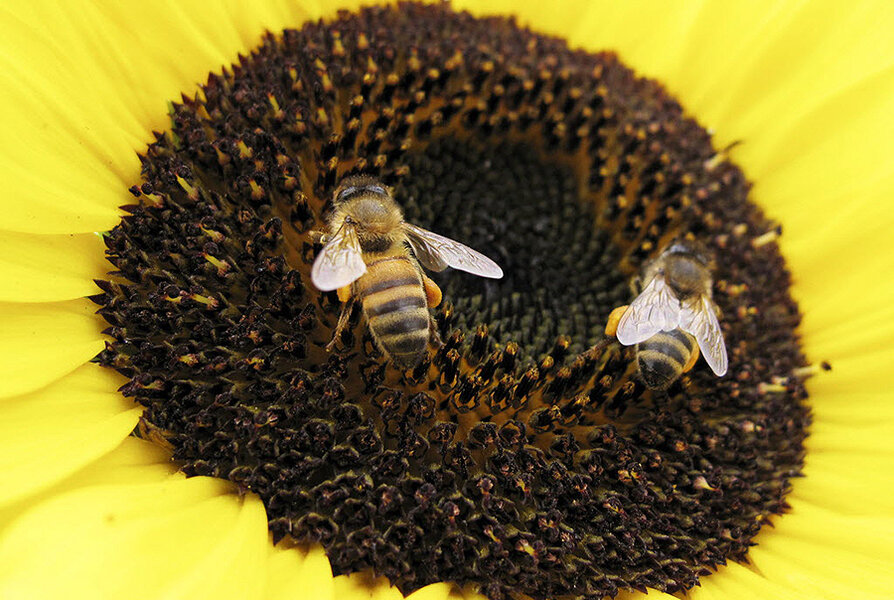First national 'bee map' charts their decline – but hopes to stem the trend
Loading...
Scientists have compiled a map detailing wild bee activity across the US, but the picture it paints isn’t great.
It’s no secret that bees are struggling to stay aloft. The precise reasons are up for debate, but many experts agree that a perfect storm of pressures from pesticide use, the rise of monocrop agriculture, declines in natural habitat, and global warming are squeezing many bee populations out of existence.
And it isn’t just bees. A 2016 UN report found that 2 out of every 5 spineless pollinator species are facing extinction. Unchecked, this trend could have disastrous consequences for global agriculture.
As much as one-third of the crops raised around the world depend on pollinators to flower, accounting for up to half a trillion dollars in value. Of that, $3 billion comes from the US.
Our fate is linked with that of our flying friends. "If we want to say we can feed the world in 2050, pollinators are going to be part of that," Dennis vanEngelsdorp, a bee expert at the University of Maryland, told the AP last year.
To understand how the bee crisis is affecting the US, researchers from four American universities teamed up to compare habitat distribution with field observations to create a model that predicted how many bees lived where. The map, originally published in 2015, was highlighted this week at the American Association for the Advancement of Science (AAAS) annual meeting, during the panel Plan Bee: Pollinators, Food Production and U.S. Policy.
"This study provides the first national picture of wild bees and their impacts on pollination," said University of Vermont conservation ecologist Taylor Ricketts, according to a press release.
And that picture was troubled. The map singles out well over a hundred counties where bee populations don’t seem up to the task of pollination. Worryingly, many of the counties fall in major agricultural production zones in places such as California, the Pacific Northwest, and the Great Plains.
The shortfall is most dramatic in areas that focus on specialty crops like apples and berries, which are especially reliant on pollinators.
"Wild bees are a precious natural resource we should celebrate and protect," said Dr. Ricketts. "If managed with care, they can help us continue to produce billions of dollars in agricultural income and a wonderful diversity of nutritious food."
North American farmers often rely on keeping stacked white boxes full of European honeybees to meet their pollination needs, but a rising demand for crop production also raises the demand for beehives to pollinate those crops. That pressure, combined with the declining health of bee populations, is putting farmers in an economic pinch, and many hope that wild bees could step up and fill the gap.
"Most people can think of one or two types of bee, but there are 4,000 species in the U.S. alone," Insu Koh, a UVM postdoctoral researcher, said at AAAS. "When sufficient habitat exists, wild bees are already contributing the majority of pollination for some crops. And even around managed pollinators, wild bees complement pollination in ways that can increase crop yields."
So what’s being done? The map is a first step, its creators say, and Ricketts is also developing an app to help farmers attract and keep more wild bees on their properties.
"The good news about bees," said Ricketts, "is now that we know where to focus conservation efforts, paired with all we know about what bees need, habitat-wise, there is hope for preserving wild bees."
Those conservation efforts vary from place to place. The European Union has banned certain types of harmful pesticides, an NGO in Latin America is working to preserve native bee-friendly plant species and habitats, and the Ginza Honey Bee project encourages urban beekeeping in Tokyo.
Others are turning to technology. A Japanese research team recently succeeded in pollinating Japanese lilies using a small drone, and roboticists from MIT and Harvard have designed a small flying robobee.
But as it stands now, a future where swarms of autonomous drones pollinate our food for us is a far-off, expensive dream. The current European honeybee economics that brings us apples and almonds, for comparison, works out to about 0.035 cents per bee per day.
With that kind of competition, bee drones would be a tough sell. "I'm not sure that's going to be cheap enough to not make blueberries hundreds of dollars a pint," Ricketts previously told the Monitor.
Fortunately, everyone can be part of the solution. The US Forest Service recommends several steps you can do to help out: for example, plant native species of flowers, avoid using chemicals, and provide a welcoming environment with good places to nest.








